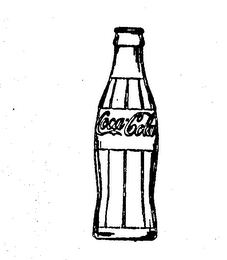What's in a bottle? If the bottle in question is shown below, the answer is protected trade dress. The Coca-Cola Company presently maintains several active registrations for many of its bottle shapes. See, e.g., Trademark Reg. No.'s 696147, 4242307, 4200433
These registrations serve as "prima facie evidence" of, among other things, The Coca-Cola Company's "exclusive right to use the registered [trade dress] in commerce on or in connection with the goods or services specified in the registration[,]" subject to defenses such as abandonment, descriptive fair use, and functionality. Other sellers that use a confusingly similar bottle shape without authorization from The Coca-Cola Company could be sued under the Lanham Act, § 32 or § 43, even if they don't use the well-known Coca-Cola names or color schemes. That is what trade dress protection can accomplish.
In their fascinating new essay, "The Coca-Cola Bottle: A Fragile Vessel for Building a Brand," which is forthcoming in Legal Applications of Marketing Theory (Gersen & Steckel, eds), Jacob Gersen and Scott Hemphill tell the history of how The Coca-Cola Company (hereafter "Coke") secured lock-tight trade dress protection in the distinctive shapes of its bottles. The authors also previously authored a book chapter on the Coke bottle for A History of Intellectual Property in 50 Objects, edited by Claudy Op den Kamp and Dan Hunter.
Digging into historical documents — including settlement agreements resulting from litigation that Coke brought against other sellers — the authors argue that the company's trajectory towards trade dress protection for the famous Coca-Cola bottle was not as smooth as we might think. In the authors' words, it was "fragile and contingent." (2). They reveal many reasons things might have come out differently for Coke.
I won't summarize the whole essay here, because it's short and very fun to read. But I want to draw out what I see as one of the authors' most important insights. They show that Coke secured common law trade dress protection by initially using design patent law. They argue that, under contemporary legal principles, courts might have rejected this strategy and not permitted Coke to use unfair competition law to protect its bottle shapes following the expiration of Coke's design patents. This is, after all, what the Supreme Court did in 1938 when it did not let Nabisco stop other sellers from using the "pillow shape" of Nabisco's shredded wheat cereal following expiration of Nabisco's patents. Things did not come out that way. Coke's strategy was a winner. But the authors suggest things could have gone very differently.


